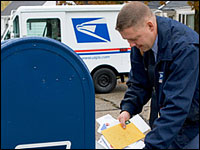The U.S. Postal Service didn’t adequately follow its own rules last year, when it secretly recorded and shared information about some 49,000 pieces of mail to further criminal and national security investigations, according to an audit report from the USPS Office of Inspector General.

Though originally released in late May, the audit report was not widely publicized until The New York Times published a related story this week.
Information recorded under the service’s longstanding mail cover program is limited to what’s written on the exterior of the packages and letters, such as names, addresses and postmark dates, and it’s collected at the request of law enforcement agencies and the Postal Inspection Service. Contents of the items are not inspected.
The purpose of the monitoring is to protect national security, locate fugitives, obtain evidence, or help locate stolen property, the USPS OIG said.
However, there have been a number of problems with the process, the audit found. Requests for surveillance on 21 percent of the 196 pieces of mail included in the study were approved without the required written authorization, for instance; 13 percent were not adequately justified.
Remedies Under Way
The main problem the audit revealed is that controls over mail cover requests weren’t always followed, Mark Duda, assistant inspector general for audits with the USPS OIG, told the E-Commerce Times.
The 196 instances examined as part of the audit were all external requests from law enforcement, he noted. All of them were required to make it clear how their requests related to criminal activity, and how specific information from mail cover surveillance could aid their investigation.
That didn’t always happen.
“We found instances where requests were approved when they couldn’t support the justification for approval,” Duda said.
Following its investigation, the USPS OIG made four recommendations for improving the system, he noted. Postal Service management agreed to all four of them and already has completed steps to address all but one.
The last one — intended to remedy data inaccuracies in the technology used for recording mail cover information — is scheduled for completion by June 2015.
Targeted vs. Dragnet Approach
“While this authority isn’t new, the fact that the government is tracking so many Americans is surprising,” Jameel Jaffer, deputy legal director with the ACLU, told the E-Commerce Times.
“When a targeted surveillance tool is used on this scale, the distinction between targeted and dragnet surveillance begins to seem academic,” he added.
“The fact that the government is monitoring so many people without probable cause or judicial oversight is yet another reminder that the rules limiting government surveillance are both too lenient and too weakly enforced,” Jaffer said.
More Clarity, More Disclosure
The number of requests that have been granted is “pretty shocking,” agreed John Simpson, privacy project director with Consumer Watchdog.
“I understand there could potentially be a legitimate need for mail covers, but they have to have some very clear procedures about when they’re used and how they’re authorized,” Simpson told the E-Commerce Times. “There’s a tremendous amount revealed by knowing who was writing letters to whom.”
There also needs to be a lot more disclosure about the Postal Service’s surveillance activities, Simpson said.
“This audit was very good, but every few years is not enough — I think there should be a requirement for a quarterly report on the number of requests granted, perhaps even listing the requesting agencies,” he suggested. “That would go a long way toward making this more transparent.”
Increasing Privacy Concerns
“Americans know that their privacy rights have diminished in view of the terrorist threat,” technology attorney and educator Raymond Van Dyke told the E-Commerce Times.
While the contents of the mail so far have been off-limits, it soon may be possible for mail cover surveillance to go beyond simply recording what’s written on the outside of a letter or package, he suggested.
“With new technologies, I imagine the entire contents of a sealed envelope can be ‘read’ through enhanced imaging techniques,” Van Dyke said, “making the privacy concerns regarding mail more acute.”
































































Social Media
See all Social Media